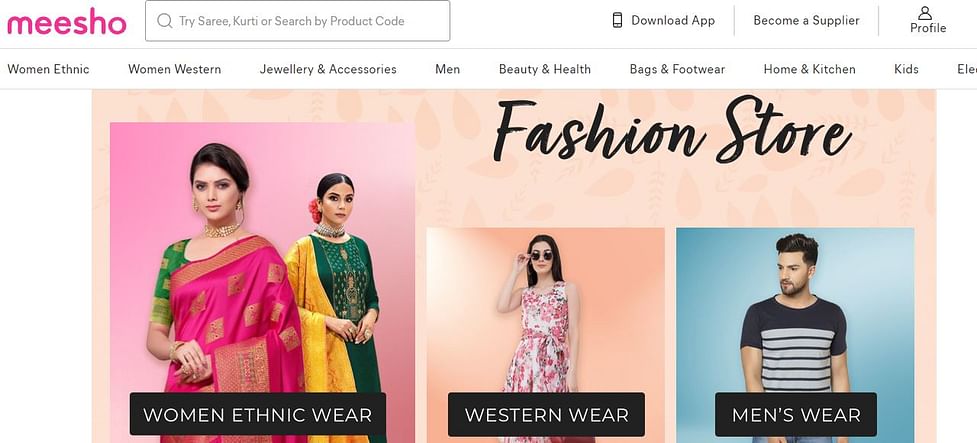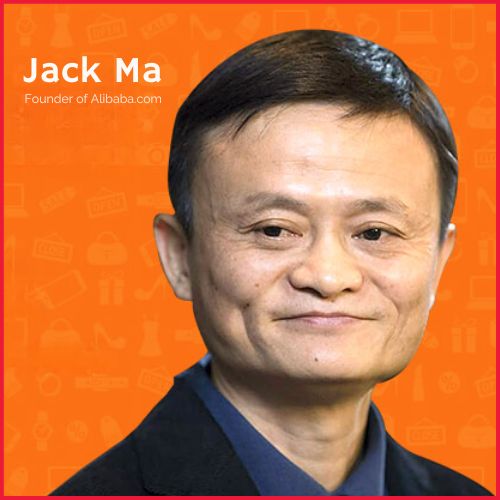In 2015, when Meesho was begun, it was known as FASHNEAR. The thought behind FASHNEAR was very much like Swiggy or Zomato. FASHNEAR managed Fashion related products and permitted clients to purchase garments and style adornments from the shops in their area. Nearby shops selling attire and adornments could enroll with the FASHNEAR application, and clients can arrange from these neighbourhood shops, and conveyance people were there to get it done.
In the online affiliate stage Meesho maybe requires no presentation. The stage has cut a specialty for itself and has acquired ubiquity among buyers and retailers the same by making web-based exchanging and shopping bother-free and reasonable. Meesho gives secure and convenient exchanges, as well as minimal expense returns and delivery. More than 2.6 million affiliates all through India trust Meesho.
About Meesho
Meesho, India’s biggest resale stage, was established in 2015. Meesho application basically associates producers with affiliates. Makers list their items on the Meesho shopping application, which permits shoppers to browse any of their items and offer them to clients utilizing informal organizations like WhatsApp, Facebook, and Instagram. Clothing, extras, furniture, culinary utensils, and beauty care products makers are among the providers who list their items on Meesho.
Free affiliates can then pick any item from these providers and offer it to clients utilizing the web-based entertainment locales referenced. It’s all around as basic as posting a photograph of the thing on Instagram or composing a Facebook post to sell it. After the client and the affiliate have settled on the buy, the Meesho things are conveyed to the purchaser’s home. Purchasers have the choice of paying with a charge/Mastercard or money down for a safe and speedy strategy of exchange.
Meesho Founders and Team
Sanjeev Barnwal and Vidit Aatrey founded Meesho in 2015.
Sanjeev Barnwal
Sanjeev Barnwal is the Co-originator and Chief Technological Officer (CTO) of Meesho. Sanjeev Barnwal has likewise worked at Sony Mobile Communications as an Android Camera Hardware Abstraction Layer Architecture Designer and Developer. He moved on from IIT Delhi with a four-year college education in design and has additionally worked with Sony Corporation before that.
Vidit Aatrey
Vidit Aatrey is the Co-originator and CEO of Meesho. Preceding Meesho, the Meesho Co-organizer worked with the versatile promoting stage InMobi, where he planned development methodologies for the organization. Aatrey has likewise seen the Operations part of the business when he was with ITC Limited.
Meesho employs over 750 people in its team.
How was Meesho started?
How did Meesho succeed?
Everybody and independent companies start their web-based stores through friendly channels like Facebook, WhatsApp, Instagram, and so forth. In 2019, Meesho got funding from Facebook, becoming the first Indian startup to receive investment from the American virtual entertainment and innovation organization, Facebook.
Everyone and independent companies start their web-based stores through friendly channels like Facebook, WhatsApp, Instagram, and so forth. Meesho became the first Indian startup to receive investment from Facebook, based on their thought of engaging women and supporting Micro, Small and Medium Enterprises (MSMEs).
The social trade area was in a state of struggle before Meesho appeared in 2015.

Thus, Meesho has altered this specific industry and has made it ready for some comparable organizations. In spite of this, the authors didn’t consider “Meesho” as the underlying brand. Their startup was called Fashnear. It would have been identical to what Zomato is really going after; and what Grofers is really going after, assuming it had been in existence today.
Another decision-based shopping technique was needed by the authors. The conveyance leader can deliver 3 items on the double to the client’s house. Upon conveyance, they could choose at least one item and pay only for that. Upon delivery, he would carry the remaining items back with him. It was the underlying arrangement behind Fashnear, as strange as that might sound. The plan was fortunately not carried out.
Meesho Case Study
Meesho is one of the quickest developing social online business organizations, and it was sent off with an altogether different business thought.
Also, the contextual investigations are made distinctly on those plans of action which have been executed effectively with novel business thoughts and systems.
Likewise, Meesho tracked down an escape clause in the market in the exchanging business and afterwards began their own startup, and today you can see where it is!
Along these lines, without with nothing to do, we should investigate the Meesho Case study, and profound plunge into Meesho’s plan of action, business technique, income model, and all things.
Is Meesho Successful?
In merely 5 years they reached the milestone of $1 Billion Valuation. They currently raised funds from Softbank Vision Fund 2 of $300 Million with a valuation of 2.1 billion.
Meesho Success Story
What is the idea behind Meesho?
Vidit Aatrey (Founder CEO) said “Meesho” means “Meri Shop” or apni dukaan. Meesho assists people to begin their own web-based selling business with Zero Investment in light of the fact that most people need to go into the business however they don’t approach capital.

In 2015, when Meesho was begun, it was known as FASHNEAR. The thought behind FASHNEAR was very much like Swiggy or Zomato. FASHNEAR managed Fashion related products and permitted clients to purchase garments and style adornments from the shops in their region. Neighborhood shops selling clothing and adornments could enroll with the FASHNEAR application, and clients can arrange from these nearby shops, and conveyance people were there to get it done.
Nonetheless, soon the originators began to see a few imperfections in the FASHNEAR plan of action. A few significant disadvantages they saw were that customers were very little worried about purchasing garments from nearby shops. Furthermore, the retailers likewise needed to increment deals by selling their items online in various areas of the country, instead of selling their items locally. These issues roused Vidit and Sanjeev to deal with a superior plan of action. Before the finish of 2015, Fashnear was renamed ‘Meesho’.
The originator pair visited numerous retailers and affiliates to recognize their concerns. They saw that numerous business people were at that point selling merchandise through WhatsApp, yet their span was restricted on the grounds that they convey their products locally as it were. They additionally figured out that a large portion of the shops enrolled on MEESHO were worked by ladies, and these ladies sold their merchandise out of their homes as opposed to any actual shops.
Meesho’s present plan of action has been assembled thinking about these realities and issues, and right now, with Meesho, ladies can easily begin an exchanging business from home, without owing any stock. Meesho additionally now enables little shops and makers to convey their merchandise the nation over, while Meesho deals with the conveyance of the items, work with COD choices, and guarantees that purchasers can flawlessly return the items assuming they wish.
Hence Meesho fills in as an extension between providers (makers and retailers who list their items on Meesho), affiliates, and clients. Meesho likewise assists providers with dealing with their inventories.
Challenges Faced by Meesho
At the point when Meesho was getting going, web-based retailing was turning out to be progressively famous, yet there were obstructions like a lack of supply, transportation, exchange choices, etc.
As per the CEO, they have generally supported little firms in their development, and therefore, they have never kept up with any products in their own distribution centers. In any case, because of the COVID-19-prompted lockdown, getting things provided demonstrated hazardously. Indeed, even after the public authority allowed a humble facilitating on vehicle portability, things stayed testing.
Meesho gave most of the pay for a large number of the providers that sold their items with them. Most of their income was affected by Covid. Subsequently, during the initial little while, their select accentuation was on laying out a fundamental calculated network. This was a troublesome assignment on the grounds that each state has its own arrangement of regulations for vehicle confirmation and exit.
The greater part of the income for the female business visionaries (re-dealers) of the organization came from the design area, however, these things couldn’t be sent for a period since the style was excluded under the necessities. Accordingly, their first goal was to help these affiliates in recovering a piece of their lost income. That is the point at which they started pushing imperative supplies to their affiliates, which was a classification they had never sold already. Covers, individual considerations, sanitisers, and even basic foods were among the things sold. They likewise conceived a plan to sell covers made at home by their own affiliates.
A large number of their vendors settled on sewing covers at home, and they bought their stock from them and sold it all alone, available. The association had a large number of business visionaries participate in the drive, and their operations group even returned home and got high-quality covers.
Not every person, in any case, had the option to adopt part in this impromptu creation strategy. Subsequently, they contrived a miniature credit way to deal with a guarantee that their affiliates had the option to bring in some cash. They gave their affiliates unassuming advances of Rs 5,000 as a feature of this program. They had the option to give these advances with no conventional screening or administrative work since they had all of their affiliates’ financial balances and income data. Indeed, even in these unsure times, they can infer that “these moves fortified our relationship and entrust with our client base.”
Meesho had genuinely come up as a banner kid in the social business section some time prior with its $4.9 bn valuations that it posted, however presently the organization is by all accounts seeing difficult stretches and is silenced before the financial backers with an adjustment of technique, high money consumes, not a single benefit to be seen and expanding contest from enormous players like Flipkart and Amazon. The organization of late changed its plan of action and made it like that of the web-based business stages.
Meesho has unexpectedly changed its system from social trade to B2C, unloaded worldwide extension to encourage modest community food, and has likewise hopped from a zero-commission model to advertisement adaptation. An unknown financial backer had as of late expressed that the organization had previously spent more than $500 mn in recent years, however, is presently back to the beginning line.
The rivalry has trebled for Meesho, which once had more modest players like Shop101 and Glowroad to rival. Presently, Meesho is confronting tough opposition from greater web-based business players like Flipkart and Amazon. With its Shopsy application, Flipkart has previously entered the social trade area in July 2021 and has tested Meesho alongside removing a lump of its affiliates. Plus, Shopee, Southeast Asia’s well-known eCommerce stage has been sent off in India in 2021, which is likewise giving a difficult stretch to Meesho. Shopee has proactively fabricated a $150 bn business in 13+ nations across Asia, South America, and Europe.
Meesho – Growth and Revenues
How is Meesho profitable?
As of now, the significant type of revenue for Meesho is through Ads and Rank push. Very much like Amazon and Flipkart, Meesho likewise permits its providers to run promotions and feature their items to a more extensive arrangement of clients. The best part is, the dealer would possibly be charged provided that a client taps on its advertisement.
During its leader, occasional deal occasion, Maha Indian Shopping League held during the sixth ninth October 2021, Meesho saw a 750% increment in clients over the earlier year i.e 2020. Level 4+ business sectors represented around 60% of absolute interest, including distant like Khawzawl in Mizoram and Sopore in Jammu and Kashmir.
As per the organization, shippers on Meesho saved over Rs 13.6 crore during the Christmas deal occasion alone due to its industry-first 0% commission conspire, which was sent off recently. During the Maha Indian Shopping League, the firm had a 314% expansion in dealer interest, bringing about a 10X expansion in incomes over the earlier year. Meesho onboarded north of 100,000 sellers in front of the deal occasion with various new drives, including free promotion credits and no return transporting charges for the initial 30 buys.
During the deal time on Meesho, clients saved around Rs 60 crore in limits. In its design fragment, the firm had a ton of achievements. In contrast with the earlier year, orders for ladies’ garments and extras expanded by 623%, while orders for men’s clothing expanded by 640%.
Meesho turned into the furthest down the line startup to join the famous unicorn club in April 2021, in the wake of getting $300 million in another venture round led by SoftBank Vision Fund 2, esteeming the organization at $2.1 billion. The organization was last esteemed at $5 bn in March 2022.
In the Financial year 2020, Meesho made income worth INR 341.6 Cr, the working incomes of which were recorded at Rs 307 cr. The organization’s costs added up to INR 657 cr during a similar monetary, in this manner the organization brought about misfortunes worth INR 306.70 cr in FY20. Meesho, which has enlisted a 3.8X development in FY20, has again seen a 2.6X development of working incomes in FY21, making it two continuous long periods of development for the social trade business. Alongside helping its working income to Rs 793 crore, Meesho has additionally procured non-working incomes worth Rs 48.5 crore.
On the costs front, Meesho spent Rs 1,337.3 crore in FY21, which saw a flood of around 104% from Rs 655.4 crore, which is brought up in FY20. Meesho needed to spend Rs 1.69 to procure a solitary rupee of income during FY21, which is a 20.6% development from what it spent to acquire something similar in FY20. The social trade unicorn needed to spend Rs 2.13 during FY20.
Meesho Future Plans
In 2020, the organizers presented another change wherein they chose to acknowledge direct requests from the clients. Nonetheless, the affiliates of the stage were not content with the choice. The organization began with attention on friendly web-based business, however, its immediate showcasing with clients has expanded enormously.
Meesho began with two significant objectives for example to make quality items accessible at sensible costs for all and to give a web-based stage to house producers to begin their web-based business with zero venture. Along these lines, the startup has achieved its objective and we trust it acquires a few changes to work on its relationship with the affiliates.
By December 2022, Meesho desires to have 100 million months to month value-based clients. It intends to utilize the new measure of the venture to twofold its specialized and item abilities, grow its item program to the north of 50 million merchandise, and become India’s favoured stage for clients, business visionaries, and merchants.
Farmiso (Meesho Grocery), Meesho’s local gathering buying (CGB) organization, is additionally attempting to expand its basic food item and quick shopper items administrations to more than 200 urban areas. The startup is empowering first-time clients in Quite a while’s level II business sectors to buy from a huge grouping of food varieties at ticket sizes as low as $1-2 by making the web shopping for food modest.














